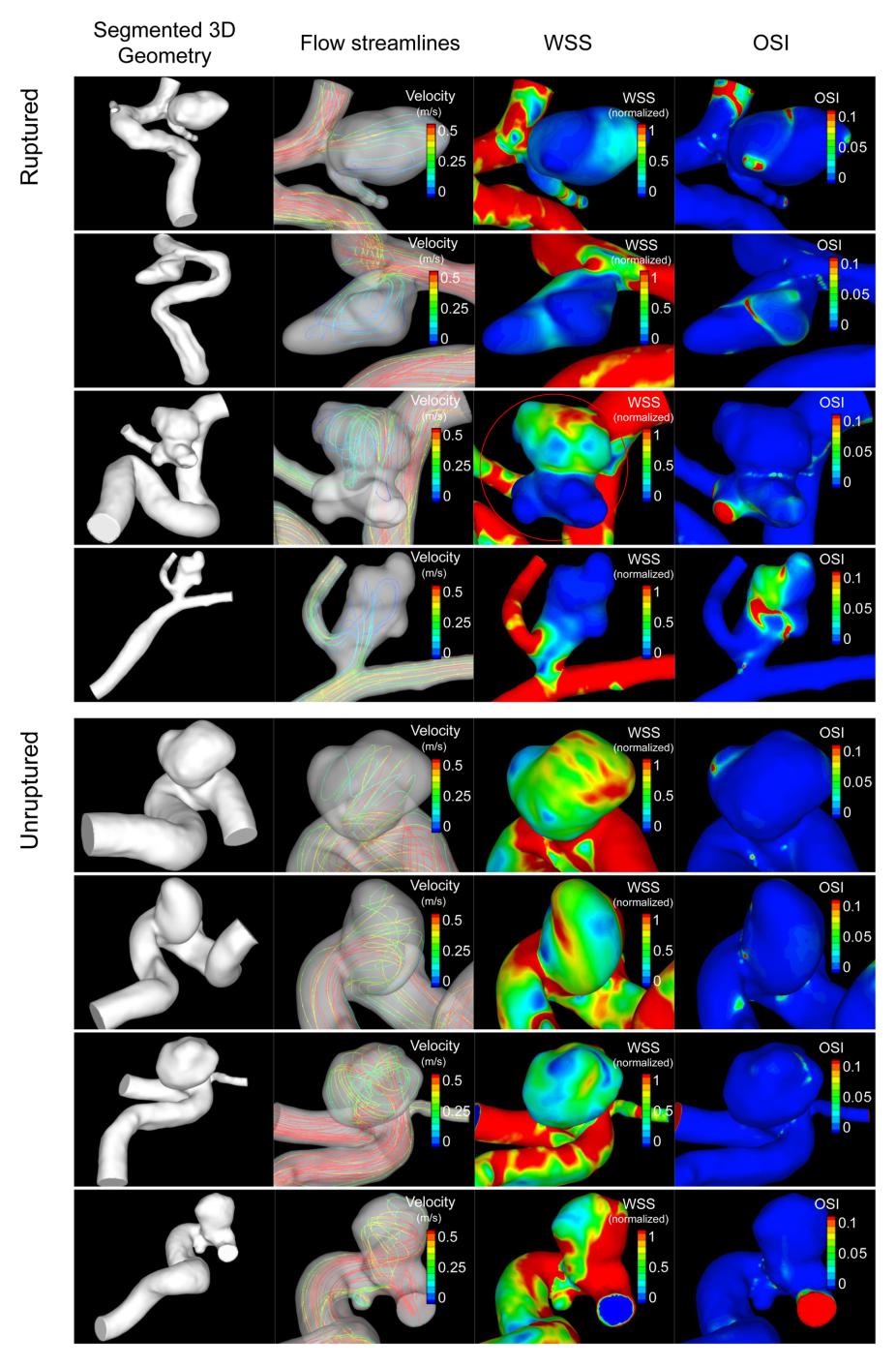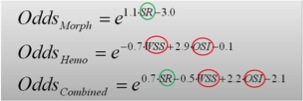Predicting Intracranial Aneurysm Rupture Risk
With the recent developments in neuro-imaging the number of asymptomatic aneurysms detected in patients has drastically increased. Although there is a high incidence of IAs in the general population there is a relatively low incidence of aneurysm rupture (1.5% of aneurysms will rupture). As a result clinicians are routinely faced with the dilemma whether or not to treat the patient. At this time the only factor clinically used to evaluate the rupture risk of an aneurysm is the size of the aneurysm. However, aneurysms below the identified size threshold of 7mm still account for the majority of aneurysms that do in fact rupture. Recognizing that size may not be the best nor the only predictor of aneurysm rupture our lab has set out to identify which morphological and hemodynamic parameters can be used to predict if an aneurysm will rupture.
Using a growing database of patient-specific aneurysm geometries we have analyzed a number of morphological and hemodynamic parameters in order to determine which parameter(s) stratify ruptured aneurysms from the unruptured group. In order to accomplish this task, 3 statistic aneurysm rupture status stratification models were built based on morphology, hemodynamics and the combination of the two categories.
Each of these models predicts the Odds that a ruptured IA is correlated with specific morphology and/or hemodynamic parameter (Odds=p/(1-p), p: probability). From these models we have demonstrated t hat high rupture risk is associated with high size ratio (SR) (aneurysmal maximal size / parent vessel diameter), low wall shear stress (WSS: the friction force between blood and vessel wall) and high oscillatory shear index (OSI: capture the level of WSS direction change in one cardio cycle). Calculations of hemodynamic parameters for each specific aneurysm geometry were determined using computational fluid dynamics (CFD) with representative WSS distributions from 9 aneurysms shown on the right.
hat high rupture risk is associated with high size ratio (SR) (aneurysmal maximal size / parent vessel diameter), low wall shear stress (WSS: the friction force between blood and vessel wall) and high oscillatory shear index (OSI: capture the level of WSS direction change in one cardio cycle). Calculations of hemodynamic parameters for each specific aneurysm geometry were determined using computational fluid dynamics (CFD) with representative WSS distributions from 9 aneurysms shown on the right.
Furthermore, using these equations the probability of whether or not a specific aneurysm will rupture can be predicted. For example, when size ratio is low (SR equals 1) , the Odds equals 0.15 and the probability of the aneurysm being ruptured is only 10%. When size ratio is high (SR equals 4), the Odds equals 4.01 and the probability of rupture is 80%. In a clinical setting such a model would be advantageous to a clinician who could use the probability data to aid in making treatment decisions for unruptured aneurysms.
For more informtion, please contact Jianping Xiang at jxiang2(at)buffalo.edu.
Further Reading:
Xiang J, Natarajan SK, Tremmel M, Ma D, Mocco J, Hopkins LN, Siddiqui AH, Levy EI and Meng H, "Hemodynamic Morphological Discriminants for Intracranial Aneurysms Rupture", Stroke, 42:144-152, 2011. PMID: 21106956
Xiang J, Yu J, Choi H, Fox Dolan J, Snyder K, Levy EI, Siddiqui AH, Meng H, “ Rupture Resemblance Scale (RRS)?Toward Risk Stratification of Unruptured Intracranial Aneurysms Using Hemodynamic-Morphologic Discriminants”, J Neurointerv Surg, 7(7):490-5, 2015. PMID: 24811740
Xiang J, Yu J, Snyder K, Levy EI, Siddiqui AH, Meng H, “ Hemodynamic-morphological discriminant models for intracranial aneurysm rupture remain stable with increasing sample size”, J Neurointerv Surg, [Epub ahead of print], 2014 Dec 8. PMID: 25488922
Xiang J, Siddiqui AH, Meng H, “ The Effect of Inlet Waveform Boundary Conditions in Computational Hemodynamics of Intracranial Aneurysms”, Journal of Biomechanics, 47(16):3882-90, 2014. PMID: 25446264
Meng H, Tutino VM, Xiang J, Siddiqui A, “High WSS or Low WSS? Complex Interactions of Hemodynamics with Intracranial Aneurysm Initiation, Growth, and Rupture: Toward a Unifying Hypothesis”, AJNR Am J Neuroradiol, 35(7):1254-62, 2014. PMID: 23598838
Xiang J, Tutino V, Snyder K, Meng H, “ CFD: Computational Fluid Dynamics or Confounding Factor Dissemination? The Role of Hemodynamics in Intracranial Aneurysm Rupture Risk Assessment”, AJNR Am J Neuroradiol, [Epub ahead of print], 2013 Sep 12. PMID: 24029393


